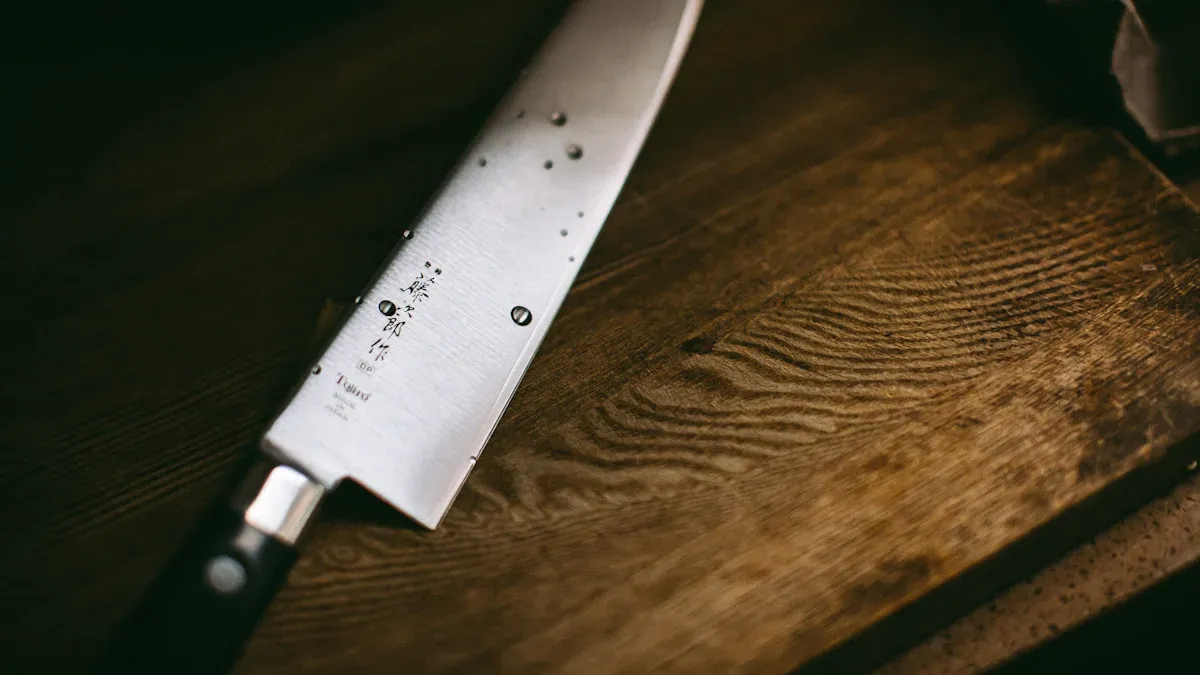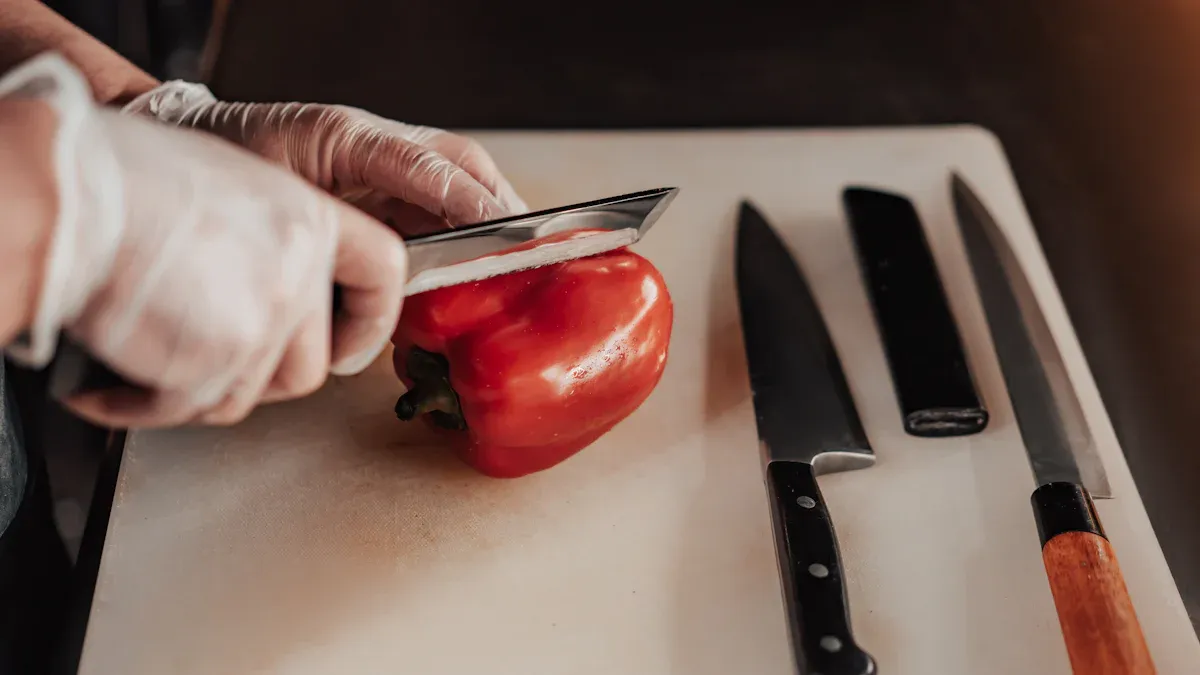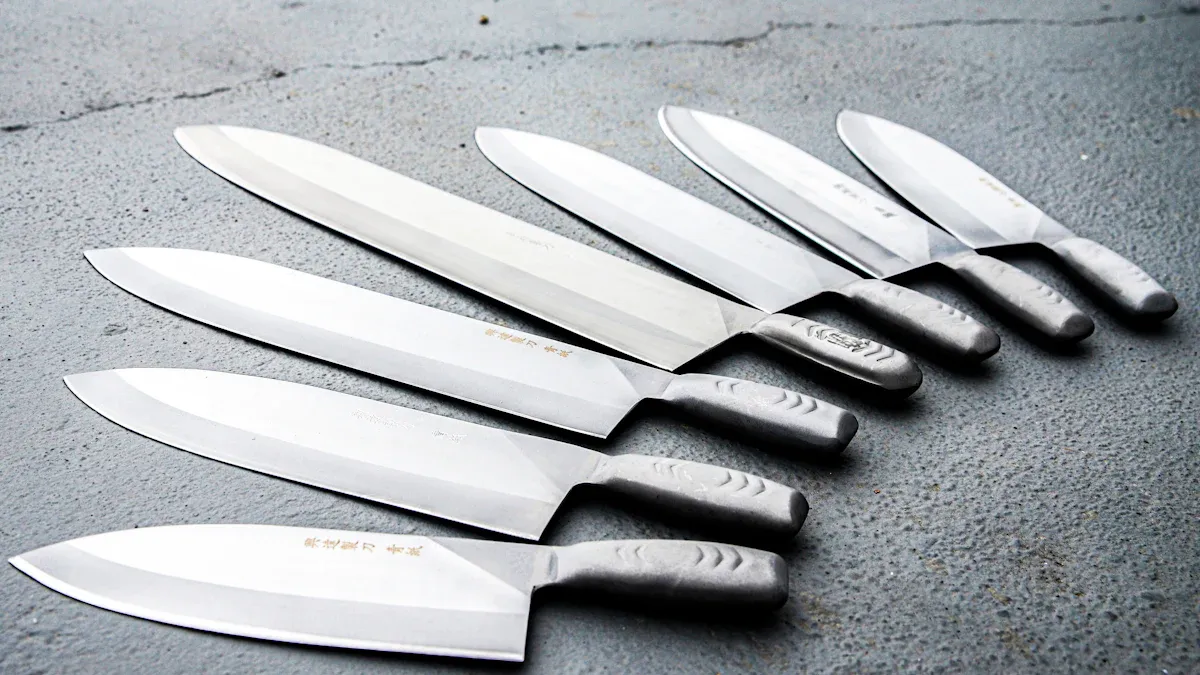The average kitchen knife degree with tuskblade

The angle of an average kitchen knife blade is very important. Most kitchen knives have an edge angle of 15-20 degrees. This angle keeps the knife sharp and strong for daily use. For instance, sharper edges (15°) cut soft foods easily, while wider angles (20°) are stronger for harder foods.
Blade angle changes sharpness and cutting effort. Tests show that thinner edges stay sharp longer. An average kitchen knife with a 15° blade stays sharp better than a 20° blade. Sharper blades also require less effort to cut, making work easier.
The tuskblade is special because of its smart design. Its angle and material improve cutting and last longer. It is a great tool for today’s kitchens.
Key Takeaways
- Most kitchen knives have a blade angle of 15-20 degrees. A smaller angle (15°) works well for soft foods. A larger angle (20°) is stronger for cutting harder foods.
- The tuskblade has a sharper angle (12-15 degrees) and strong materials. This design helps it cut cleaner and stay sharp longer.
- Picking the right blade angle is important. A 15-degree angle is great for detailed cutting. A 20-degree angle is better for strength and lasting use.
- Taking care of your knife is very important. Sharpen it often and use the right tools. This keeps the blade sharp and ready for cooking tasks.
- The tuskblade is easy to use and very useful. It can slice soft foods or chop tough ones, making it a great tool for any kitchen.
Understanding the Average Kitchen Knife Degree

Western vs. Asian kitchen knives
When picking a kitchen knife, you’ll see big differences. Western knives are thicker and heavier. They are made to last and handle tough jobs. These include cutting bones or hard vegetables. Most Western knives have a 20-degree sharpening angle. This angle makes the edge strong and long-lasting.
Asian knives are thinner and lighter. They are made for precise and delicate tasks. These include slicing fish or soft vegetables. Most Asian knives have a 15-degree sharpening angle. This creates a sharper edge for clean cuts. Traditional Japanese knives are often sharpened on one side only. Western knives are usually sharpened on both sides, making them more flexible for many tasks.
Knowing these differences helps you pick the right knife. If you need a strong knife for tough jobs, choose a Western knife. For detailed and careful cuts, an Asian knife is better.
Common blade angles and their purposes
The angle of a knife blade changes how it works. Sharper angles, like 15 degrees, are great for precise tasks. These include slicing fruits, cutting fish, or soft vegetables. Wider angles, such as 20 degrees, are stronger and last longer. They are good for chopping hard foods like squash or root vegetables.
Here’s a simple guide to blade angles:
- 15 degrees: Best for careful cuts and small tasks.
- 20 degrees: Great for strength and daily use.
- 22-30 degrees: Perfect for heavy jobs, like cutting bones.
The angle also affects how long the edge stays sharp. Sharper blades cut cleaner but dull faster. Wider angles last longer but need more effort to cut. Picking the right angle helps your knife work best for your needs.
Materials and their influence on blade angles
The material of a knife decides its best blade angle. Harder materials, like high-carbon steel, can keep sharper angles longer. Softer materials, like stainless steel, need wider angles to stay strong.
Studies show heat treatments can make knife materials harder. This process improves sharpness and durability. For example, a high-carbon steel knife with a 15-degree angle stays sharp longer than a stainless steel knife with the same angle.
When buying a knife, think about the material and your cooking style. Harder materials are great for precise tasks. Softer materials are better for general cooking jobs.
Exploring the Tuskblade in Kitchen Knives

What makes the tuskblade unique?
The tuskblade is special because of its smart design and great performance. Unlike regular knives, it uses advanced technology and strong materials for better results. Its curved blade shape helps cut more easily. This design lowers resistance, so slicing food takes less effort.
Its material is another standout feature. Many tuskblades are made from high-carbon steel or special alloys. These materials keep the blade sharp and strong for a long time. The blade doesn’t chip and stays sharp longer than most regular knives. Plus, the handle is designed to fit your hand comfortably, making it easier to use for a long time.
Tip: Want a knife that’s both sharp and strong? Try the tuskblade.
Blade angle of the tuskblade compared to the average kitchen knife
The tuskblade has a sharper angle than most kitchen knives. Regular knives usually have a 15-20 degree angle, but the tuskblade often has a 12-15 degree angle. This sharper edge makes cutting cleaner and more exact. It’s great for slicing fish, chopping vegetables, or carving meat.
Even with a sharper angle, it stays strong. The tuskblade’s high-quality materials keep the edge durable, even with heavy use. This mix of sharpness and strength makes it useful for both chefs and home cooks.
Note: Sharper blades need care. Keep your tuskblade sharp by honing it often and handling it carefully.
Benefits of using a tuskblade in the kitchen
Using a tuskblade has many benefits. First, its sharp edge makes cutting easier. You’ll cut faster and save time when cooking.
Second, the tuskblade lasts longer and doesn’t need sharpening as often. This makes it a good investment for your kitchen.
Third, its handle is comfortable and easy to control. Whether you’re slicing or chopping, the tuskblade feels balanced in your hand. This lowers the chance of accidents and makes cooking more fun.
Finally, the tuskblade is very versatile. It can handle soft tasks like slicing herbs and tough jobs like cutting squash. This makes it a great tool for any kitchen.
Did you know? The tuskblade’s sharp angle and strong materials make it perfect for both detailed and tough cutting tasks.
Impact of Blade Angles on Performance
Sharpness and cutting precision
The blade angle decides how sharp and precise a knife is. A 15-degree angle makes clean, accurate cuts. This is great for slicing fish or chopping herbs. Smaller angles reduce resistance, so cutting feels easier and quicker.
But sharper angles need more care. They lose sharpness faster than wider ones. Knives with 15 to 20-degree angles may need weekly sharpening if used often. If used less, sharpening every month or two is enough.
Tip: For a mix of sharpness and strength, pick a 17-degree angle. Many professional knives, like New West ones, use this angle for the best results.
Durability and edge retention
Blade angles also affect how long sharpness lasts. Wider angles, like 20 degrees, are stronger and last longer. They wear less and keep their edge better. Tests show a 20-degree edge stays about 23 microns thick after heavy use. Higher angles, like 34 degrees, thin out to 19-20 microns.
Sharper angles, like 15 degrees, are less durable. They dull faster with heavy use. Choose an angle based on your needs. For durability, go with a wider angle. For precision, pick a sharper one.
Practical tips for maintaining blade angles
Taking care of your knife’s angle keeps it working well. Here are some easy tips:
- Sharpen often: Sharpen weekly if you use the knife a lot. For light use, sharpen monthly.
- Use proper tools: Get a sharpening stone or honing rod. These help keep the angle right.
- Avoid hard surfaces: Don’t cut on glass or stone. Use wood or plastic boards.
- Store safely: Put your knife in a sheath or block to protect it.
Note: Good care makes your knife last longer and stay sharp.
Choosing the Right Blade Angle for Your Kitchen Needs
Factors to consider based on cooking habits
How you cook affects the blade angle you need. If you often slice soft foods like fish or vegetables, pick a sharper angle (about 15 degrees). It helps make clean and smooth cuts. But if you chop hard foods like squash or bones, a wider angle (20 degrees or more) is stronger and lasts longer.
Also, think about how often you use your knife. For everyday cooking, a 17-20 degree angle works well for most tasks. If you’re a chef or love trying fancy recipes, a sharper blade might be better for you.
Tip: Choose a blade angle that matches your usual cooking tasks.
Matching blade angles to specific tasks
Different jobs need different blade angles. A sharper angle (12-15 degrees) is great for slicing herbs, cutting fruits, or filleting fish. Wider angles (20-22 degrees) are better for chopping hard vegetables or cutting through meat and bones.
Here’s a simple guide:
- 12-15 degrees: Best for slicing and detailed work.
- 15-20 degrees: Good for most cooking tasks.
- 20+ degrees: Great for tough chopping jobs.
Picking the right angle helps your knife work better and last longer.
Recommended sharpening tools and techniques
To keep your knife sharp, use the right tools and methods. A sharpening stone is great for keeping blades sharp. Use a fine-grit stone for sharper angles and a coarse-grit stone for wider ones. Honing rods are also useful for fixing the blade edge without wearing it down.
When sharpening, hold the knife at the correct angle. For example, a 15-degree angle needs a steeper tilt than a 20-degree one. Practice on an old knife if you’re unsure.
Note: Regular sharpening and safe storage keep your knife in great shape.
The angle of a kitchen knife affects how it works. A 15-20 degree angle is sharp and strong, good for most jobs. Sharper angles, like 12 degrees, cut better but need extra care.
The tuskblade is special with its sharp edge and tough materials. It cuts smoothly and stays sharp longer, making it a great kitchen tool.
Pick a blade angle that fits your cooking style. Take care of it with the right tools to keep it working well. A cared-for knife saves time and makes cooking more fun.
Tip: A sharp knife, like the tuskblade, makes cooking easier and more enjoyable.
FAQ
What is the best blade angle for a kitchen knife?
The best angle depends on what you cook. A 15-degree angle is great for slicing soft foods like fish or herbs. A 20-degree angle is stronger for cutting harder foods. Pick an angle that fits your cooking style.
How often should you sharpen a tuskblade?
If you use your tuskblade daily, sharpen it every 2-3 weeks. For less frequent use, sharpen it every 1-2 months. Use a honing rod regularly to keep the edge sharp between sharpening.
Tip: A fine-grit sharpening stone works best for the tuskblade’s sharp edge.
Can you use a tuskblade for all kitchen tasks?
Yes, the tuskblade is very useful. Its sharp blade is perfect for slicing, and its strong material handles tough jobs like chopping squash. But don’t use it on bones or frozen foods to avoid damage.
What tools work best for sharpening kitchen knives?
A sharpening stone is the best tool for keeping blades sharp. Use a fine-grit stone for sharper angles and a coarse-grit stone for wider ones. Honing rods are helpful for quick touch-ups.
| Tool | Best For | Example Tasks |
|---|---|---|
| Sharpening Stone | Sharpening dull blades | Fixing worn edges |
| Honing Rod | Keeping edges sharp | Quick daily fixes |
How do you store a tuskblade safely?
Keep your tuskblade in a knife block, sheath, or on a magnetic strip. This protects the blade and prevents accidents. Don’t leave it loose in a drawer, as this can dull the blade and cause injuries.
Note: Storing your knife properly helps it last longer.


